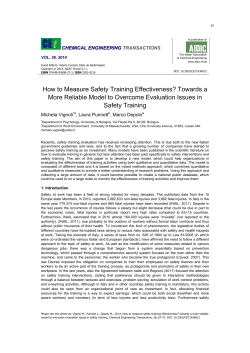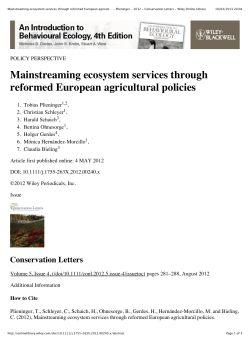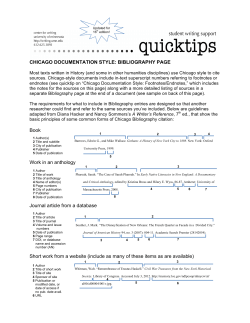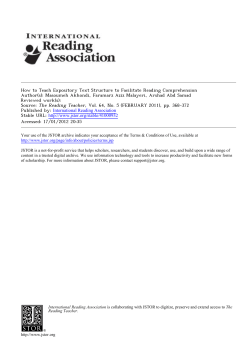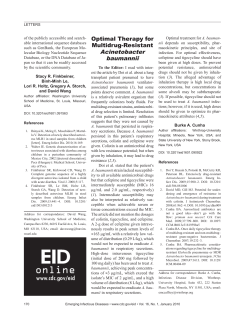
Why are there defaulters in eye health projects? CLINICAL SCIENCE Regina Noma,
CLINICS 2011;66(9):1585-1589 DOI:10.1590/S1807-59322011000900014 CLINICAL SCIENCE Why are there defaulters in eye health projects? Regina Noma,I Regina de S. Carvalho,II Newton Kara-Jose´I I Ophthalmology, Hospital das Clı´nicas da Faculdade de Medicina da Universidade de Sa˜o Paulo, Sa˜o Paulo/SP, Brazil. II Pedagogue, Faculdade de Medicina da Universidade de Sa˜o Paulo, Sa˜o Paulo/SP, Brazil. PURPOSE: To identify barriers to attendance for eye examination of schoolchildren. METHODS: Cross-sectional study. Students in grades 1-4 in elementary school in Guarulhos (Brazil) were screened and referred for ophthalmic examination in 2006. Facilities offered in this project were: examination arranged during weekends, free transportation, spectacle donation and two different opportunities for exam. A questionnaire was applied, by interview, to a sample consisted of students’ parents attended in a community project who missed the first call and attended the recall, to identify the reasons for non-attendance. RESULTS: The sample consisted of 767 parents or guardians, corresponding to an equal number of schoolchildren. Personal characteristics of the students: 49.2% male and 50.8% female, 60.2% of them had never received previous ophthalmologic evaluation. Reported reasons for no-show to the project: parents had not received appropriate orientation (35.6%), loss of working day (20.6%), illness (12.4%), had another appointment (10.0%). The need for eyeglasses was higher in the recall. CONCLUSIONS: A significant number of parents did not take their children for ophthalmological exams, even when a second opportunity was offered in projects with transportation facilities, free exams performed during weekends and spectacle donation. The main causes of absenteeism were lack of awareness and work. For 87.1% of the absenteeism cases, the difficulties could be overcome via improved structuring of the first call. A recall increases attendance coverage of target population by only 15.2% (59.3 to 74.5%). Notably, the eye exam campaign was the first exam for most of the absent students. KEYWORDS: Children; Vision screening; Acess to Care; Refractive error; Ophthalmic evaluation. Noma R, Carvalho RS, Kara-Jose´ N. Why are there defaulters in eye health projects? Clinics. 2011;66(9):1585-1589. Received for publication on April 1, 2011; First review completed on April 27, 2011; Accepted for publication June 1, 2011 E-mail: reginanoma@hotmail.com Tel.: 55 15 3212 5009 useful to the managers and those involved in the public health area, as guidance for future actions. The campaigns are also a means to educate the population to adopt preventive actions and to demonstrate the acceptance rate of the proposed treatment.5 Brazil has a extensive experience in school-based community campaigns, which have been orchestrated since 1970s.6-12 One of the problems related to these projects in several countries worldwide is the high level of absenteeism, which varies from 31.2 to 68.7%.11-17 The main reasons provided by the parents or guardians to not attend the visit are: lack of guidance (day, time and place of the exam) from the school; financial difficulty in taking transportation to the locale of the exam; distance from the locale of the visit; not having someone else to look after other children; weather changes; preference to have a visit scheduled by his/her private medical practitioner; disease; trip; forgetfulness; lack of awareness of the importance of the ophthalmologic exam or denial of the child’s low vision.7,12,13,17-20 To reduce absenteeism, some campaigns in Brazil offer facilities such as: free transportation and exam dates on the weekend, so the parents do not need to lose a work day; a second chance for an exam and the performance of the exam close to the school area where the visual screening was performed.12 INTRODUCTION The lack of optical correction is the main cause of low vision and the second cause of blindness worldwide.1 Although it is easily corrected, the optical correction problem is complex and depends on the following: suspected problem, demand, availability, access to medical assistance, acquisition and use of spectacles, and replacement in case of loss or damage.2,3 In Brazil, 78.8% of the population depends on the public health system.4 Despite the great improvement over recent years, the Public Health System (SUS) still presents a low availability of specialized services, as well as difficulties with access to optical correction and related compliance conditions.4 When the public health system is poor, the communities’ campaigns are a way to investigate a given problem’s frequency, the existing coverage and the importance and enforceability of the solution. This increase in support is Copyright ß 2011 CLINICS – This is an Open Access article distributed under the terms of the Creative Commons Attribution Non-Commercial License (http:// creativecommons.org/licenses/by-nc/3.0/) which permits unrestricted noncommercial use, distribution, and reproduction in any medium, provided the original work is properly cited. 1585 Why defaulters in ocular health projects? Noma R et al. CLINICS 2011;66(9):1585-1589 - PURPOSE To identify the reasons for non-attendance at the community projects that offer transportation facilities, meal, free ophthalmological exams performed during the weekends, a second opportunity for examination and spectacle donation. - METHODS The city of Guarulhos belongs to the metropolitan region of Sa˜o Paulo (Brazil), located 17 km from the capital and is the 12th most populated city of the country. In Guarulhos, 97.9% of the children are enrolled in schools.21 A cross-sectional, descriptive study investigated students in grades 1-4 in elementary school in Guarulhos, who were submitted to visual acuity screening by trained teachers in 2006. Children were referred to complete ophthalmologic evaluation if they presented visual acuity equal to or less than 0.7 in at least one eye or with a visual difference between the eyes of two lines or more; presence of strabismus; asthenopia; or use of spectacles.22 The exam was scheduled for the weekends (Saturday and Sunday) in the student’s own municipality. Free transportation and meals were offered. The spectacles were donated and delivered to the schools. For students who were absent at the first call, a second chance for an exam was offered, at the same facilities. A questionnaire, validated by an exploratory study and pre-tested in previous campaigns, was prepared. The following variables were studied: - Personal characteristics of the students: gender, age (in years); Ophthalmological evaluation previously received by the student (yes/no), type of health service used (public, covenant, private); Reasons for absence at the ophthalmological exam (did not receive guidelines/transmittal guide; could not miss the day of work; child’s or family’s disease; other appointment; did not have someone else to look after the other children; recent or scheduled ophthalmological exam); Need of optical correction. The instrument was applied through an interview with the parents or guardians who took his/her children to the second-chance exam. This study was approved by the Investigational Review Board for Research Project Analysis of the Clinical Directory of Hospital das Clı´nicas and Faculdade de Medicina da Universidade de Sa˜o Paulo/SP – Study Protocol n˚ 0557/07. Informed consent was obtained from each parent or guardian who participated in the study. The parents or guardians were informed that the not answering to the questionnaire would not affect the Campaign service. RESULTS Fifty-one thousand, five hundred and nine (51,509) students were screened, and 14.651 (28.4%) were referred for an ophthalmological exam. Among these patients, 8.683 Figure 1 - Flow chart of the Eye-to-Eye Campaign attendance – Guarulhos 2006. 1586 CLINICS 2011;66(9):1585-1589 Why defaulters in ocular health projects? Noma R et al. Table 1 - Coverage of ophthalmological service – Eye-to-Eye Campaign - Guarulhos, 2006 and 2007. Call Screened First call Recall TOTAL Referred Attended Absenteeism % Coverage % Coverage increasing after recall% 14,651 5,968 14,651 51,509 8,683 2,228 10,911 40.7 62.7 25.5 59.3 15.2 74.5 15.2 number of students who attended, the first call was, approximately, four times more efficient than the recall, although the cost for staging it was similar. The main reason for non-attendance was lack of awareness or failure to receive the notice about the day and place where the exam would be performed (35.6%) – Table 3. Each school was in charge of this communication step. Similar study performed in Sa˜o Paulo six years ago reported 53.7% absenteeism at the first call and 54.3% at the second call. It also identified failure to receive an orientation or transmittal guide as the main reason for the absence.13 This issue could easily be resolved with a referral letter, explaining that the child failed the school vision screening test, how the vision test was done and the importance of the follow-up eye examination. It is also important to confirm receipt of the letter and awareness of the information. However, a study performed in North Carolina, revealed that 35% did not attend exams, even after they had received the referral letter.20 These findings show that interventions to improve follow-up on school vision screening referrals represent an important component of screening programs. It also calls attention to the need to reinforce the involvement of the teachers and directors at the school in the ocular heath program, as well as the need to further develop the campaign’s logistic protocol. In previous campaigns, difficulties related to transportation were also shown as an important limiting factor,13,18 however, the offering of free transportation and the performance of the exam close to the screening place did not influence the level of absenteeism (Table 3). Even with the exam during the weekend, 20.6% of the parents reported that they did not attend the project because they could not miss work (Table 3); however, they were able to overcome the problem and attended the recall. These patients were probably encouraged by the results from students who attended the first examination. The fact that 10.0% of the parents did not attend the exam due to other appointments (Table 3) indicates the (59.3%) attended the first call. The 5.968 absent students were recalled, and 2.228 (37.3%) attended this secondchance exam (Figure 1). Among the 2.228 students who attended the second-chance exam, 1.461 (65.6%) were released during the screening period. The questionnaire was administered to 767 students who attended the secondchance exam and underwent the complete ophthalmological examination (Figure 1). Among the students examined, 50.8% were female, with ages ranging from seven to ten years old. For 461 students (60.1%), it was the first opportunity for an ophthalmological exam (Table 2). Among the 39.9% who had already submitted to an ophthalmological exam, 48.0% used the public health service (Table 2). The reasons for not attending the exam are shown in Table 3. The likelihood of a spectacle prescription at each appointment is described in Table 4. The recall facilitated a 15.2% (59.3% to 74.5%) increase in campaign coverage. Overall, 10,911 students were examined; 74.5% of those were referred for the exam (Table 1). DISCUSSION Ophthalmological campaigns for students performed in the last 40 years in Brazil6,12 introduced children and their parents to facilities to increase the attendance. However, the projects still present a high percentage of absenteeism, which results in unnecessary costs and loss of exam opportunities for the children. Even with the access to facilities, attendance during the weekends, free transportation, spectacle donation, and two opportunities for free exams, 25.5% of the parents did not take their children for the examination. Ultimately, 51,509 students were screened; 14,651 (28.4%) were referred for an ophthalmological exam and 59.3% (8,683) attended the first call. Of the 5,968 who missed the first call, only 37.3% (2,228) attended the recall. The recall increased overall attendance from 59.3% to 74.5% (15.2%) – Table 1. Regarding the Table 3 - Reason for not attending the first appointment. Table 2 - Previous ophthalmological evaluations of the students. Reason for non-attendance Previous ophthalmological exam f Previous ophthalmological exam Yes No Service Public Service Covenant System Private System Do not remember Did not know Work Disease Other appointment Forgot Missed the time Did not have anyone else to look after the other children Think the child has good vision Medical appointment scheduled Bad weather Lack of money TOTAL % n = 767 306 461 39.9 60.1 n = 306 147 81 74 4 48.0 26.5 24.2 1.3 1587 f % 273 158 95 77 48 39 36 35.6 20.6 12.4 10.0 6.3 5.1 4.7 18 17 4 2 767 2.3 2.2 0.5 0.3 100.0 Why defaulters in ocular health projects? Noma R et al. CLINICS 2011;66(9):1585-1589 Considering the extent of existing ocular health coverage, the routine eye exam required at the time the child starts going to school becomes even more important, not only to detect refractive errors, but also due to its educational role within the community. It is necessary to educate the population regarding the importance of ophthalmological exams and the adoption of ocular health-promoting behaviors,35 which would increase the attendance at campaigns and the patient-motivated search for health services. The perception of physical and mental health is one of the most significant human values. One study showed that a significant number of parents (29%) felt there was no need for a professional eye exam. Another 38% expressed lack of confidence in the screening results. These parents stated that they saw no signs of vision problems or that the child denied vision difficulties.30 It is noted that, after six years, the rates and reasons for absenteeism are the same and remain unaddressed. The measures used to increase the attendance did not have detectable influence on the rate of absenteeism. To increase attendance, restructuring of the campaigns is recommended, with emphasis on improved informationsharing, teacher involvement and community education regarding the importance of the exam. Optimal informationsharing could influence even the 25.5% of parents who did not take their children to the second-chance exam. Aside from the technical-scientific studies, a reorientation of the research in the health area, including politicalinstitutional aspects and assessment of the incorporation of new technologies, should be instituted. The promotion of strategic research is important to identify the priority areas that demand resource capitation and immediate application of the results. This study shows that restructuring of the campaigns could improve the efficiency of the campaigns (of attended students) by up to 15.2%. Table 4 - Percentage of spectacles prescribed at each appointment – Guarulhos 2006. Appointment Spectacles Yes No Total First n 2,069 6,614 8,683 % 23.8 76.2 100.0 Recall n 713 1,515 2,228 Total % n 32.0 2.782 68.0 8,129 100.0 10,911 % 25.5 74.5 100.0 p-value ,0.001 non-prioritization of the exam by the parents, even in cases when a visual problem was suspected by teachers. In a study conducted in Sa˜o Paulo six years ago, 19.4% could not miss work; 8.5% did not have money for transportation and 9.0% missed the exams due to other appointments.13 It was noted that 83.9% of the reasons for missing the first call could have been avoided. Similarly, in this study, the difficulties that justified absence at the first call were overcome for 87.1% of those who attended the recall. Only reasons related to disease (12.4%) and bad weather (0.5%) are insurmountable impediments that could justify absenteeism on the day of the exam. However, the absenteeism at the recall was much higher (62.7% at the recall and 49.7% at the first call) (Table 1). Non-attendance at the first call was also not related to the optical correction needed, as the results showed that those who were absent had a higher frequency of visual problems (Table 4). These findings confirm that there are additional barriers inhibiting follow-up after visual referral, as has been demonstrated by several studies.19,20,30 The use of the health system involves not only availability and access, but also the behavior necessary to look for existing services.2,23 Other studies showed that, after suspicion of possible ocular problems based on visual acuity screening exam, several parents or guardians waited up to four years to book an exam.20,24 Medical service barriers can be related to the user (lack of knowledge, fear, poverty, emotional difficulties, geographical distance, and cultural and behavioral aspects) and to the providers of these services (lack of motivation, training, material resources, and communication).19,20,25-30 The results of this study confirmed results of previous studies19,20,24,30 and support the hypothesis that there are multiple factors affecting follow-up compliance after failed school vision screenings. Parental reasons for not following up on referrals are complex and interventions must address multiple barriers.20,30 Among the students screened due to suspicion of visual problems and who attended the second call, this campaign was the first opportunity for ophthalmological exam among 60.1% of the cases, which indicates insufficient coverage provided by the health system (Table 2). This condition should be considered by the health managers involved with ophthalmological services. There is no consensus about the recommended age for the first ophthalmological exam. In some countries, it is recommended for patients between four and seven years old31 or is mandatory when registering the child in school.32-34 In Brazil, several attempts to institute this policy had little success.12 CONCLUSION A significant number of parents did not take their children for ophthalmological exams, even when facilities (free transportation, free exam performed over the weekend, spectacle donation, and second opportunity for exam) were offered. The main causes of absenteeism were lack of awareness and work. For 87.1% of the absenteeism cases, the difficulties could have been overcome via improved structuring of the first call. A recall increases attendance coverage of the target population by only 15.2% (59.3 to 74.5%). Notably, the eye exam campaign was the first exam for most of the absent students. ACKNOWLEDGMENTS Contributors who do not meet the criteria for authorship should be listed in the acknowledgments section. All contributors must give written permission to be acknowledged. REFERENCES 1. Resnikoff S, Pascolini D, Mariotti SP, Pokharel GP. Global magnitude of visual impairment caused by uncorrected refractive errors in 2004. Bull World Health Organ. 2008;86:63-70, doi: 10.2471/BLT.07.041210. 2. Hubley J, Gilbert C. Eye health promotion and the prevention of blindness in developing countries: critical issues. Br J Ophthalmol. 2006;90:279-84, doi: 10.1136/bjo.2005.078451. 3. Kara-Jose´ N, Mello PAA, Rodrigues MLV. Do erro de refrac¸a˜o ate´ a correc¸a˜o o´ptica. In: Kara-Jose´ N, Rodrigues MLV. Sau´de Ocular e Prevenc¸a˜o da Cegueira. Rio de Janeiro: Cultura Me´dica. 2009;289-90. 4. ANS/MS. Sistema de Informac¸o˜es de Beneficia´rios. 2008. 1588 CLINICS 2011;66(9):1585-1589 Why defaulters in ocular health projects? Noma R et al. 19. Preslan MW, Novak A. Baltimore Vision Screening Project. Phase 2. Ophthalmology. 1998;105:150-3, doi: 10.1016/S0161-6420(98)91813-9. 20. Mark H, Mark T. Parental reasons for non-response following a referral in school vision screening. J Sch Health. 1999;69:35-8, doi: 10.1111/j.17461561.1999.tb02341.x. 21. IBGE. http://www.ibge.gov.br/ibgeteen/pesquisas/educacao.html; 2003. 22. Carvalho RS, Temporini ER, Kara-Jose N. Assessment of visual health campaign activities at schools: teachers’ perception. Arq Bras Oftalmol. 2007;70:239-45. 23. Shengelia B, Murray C, Adams O. Beyond acess and utilization: defining and measuring health system coverage. In: Murray C, Evans D. Health system performance assessment: debates, methods and empiricism. Geneva: WHO. 2003: 221-34. 24. Yawn BP, Lydick EG, Epstein R, Jacobsen SJ. Is school vision screening effective? J Sch Health. 1996;66:171-5, doi: 10.1111/j.1746-1561.1996. tb06269.x. 25. Rodrigues MLV, Kara-Jose´ N. Aspectos socioeconomicos, polı´ticos, culturais e geogra´ficos da prevenc¸a˜o da perda visual. In: Kara-Jose´ N, Rodrigues MLV. Sau´de ocular e prevenc¸a˜o da cegueira. Rio de Janeiro: Cultura Me´dica. 2009;237. 26. Kovai V, Krishnaiah S, Shamanna BR, Thomas R, Rao GN. Barriers to accessing eye care services among visually impaired populations in rural Andhra Pradesh, South India. Indian J Ophthalmol. 2007;55:365-71, doi: 10.4103/0301-4738.33823. 27. Fassin D, Jeannee E, Cebe D, Reveillon M. Who consults and where? Sociocultural differentiation in access to health care in urban Africa. Int J Epidemiol. 1988;17:858-64. 28. He M, Xu J, Yin Q, Ellwein LB. Need and challenges of refractive correction in urban Chinese school children. Optom Vis Sci. 2005;82:22934, doi: 10.1097/01.OPX.0000159362.48835.16. 29. Odedra N, Wedner SH, Shigongo ZS, Nyalali K, Gilbert C. Barriers to spectacle use in Tanzanian secondary school students. Ophthalmic Epidemiol. 2008;15:410-7, doi: 10.1080/09286580802399094. 30. Kimel LS. Lack of follow-up exams after failed school vision screenings: an investigation of contributing factors. J Sch Nurs. 2006;22:156-62, doi: 10.1177/10598405060220030601. 31. Kohler L, Stigmar G. Visual disorders in 7-year-old children with and without previous vision screening. Acta Paediatr Scand. 1978;67:373-7, doi: 10.1111/j.1651-2227.1978.tb16337.x. 32. American Academy of Pediatrics Committee on Practice and Ambulatory Medicine, Section on Ophthalmology. Eye examination and vision screening in infants, children, and young adults. Pediatrics. 1996;98:153-7. 33. Commonwealth of Kentucky RS. House Bill No. 706 (as enacted). 2000. 34. Illinois. Department of Public Health. Vision Screening Manual. Springfield, State of Illinois. 2004. 35. Hubley J. Communicating health—an action guide to health education and health promotion. 2nd ed. Oxford: Macmillan. 2004. 5. Carvalho RS, Kara Jose N, Arieta CEL, Castro RS. Campanhas comunita´rias - conceitos ba´sicos. In: Kara-Jose´ N, Gonc¸alves ER, Carvalho RS. Olho no Olho. Rio de Janeiro: Cultura Me´dica. 2006;7-16. 6. Kara-Jose´ N, Ferrarini M, Temporini E. Avaliac¸a˜o do desenvolvimento do plano de oftalmologia sanita´ria escolar em treˆs anos da sua aplicac¸a˜o no Estado de Sa˜o Paulo. Arq Bras Oftalmol. 1977;40:9-15. 7. Russ HHA, Temporini ER, Kara-Jose´ N. Impacto da Campanha Olho no Olho em escolas de ensino fundamental: percepc¸a˜o do pessoal de ensino. Arq Bras Oftalmol. 2004;67:359-63, doi: 10.1590/S0004-27492004000200023. 8. Kara-Jose N, Holzchuh N, Temporini ER. Refractive errors in school children in the city of Sao Paulo, Brazil. Bol Oficina Sanit Panam. 1984;96:326-33. 9. Kara-Jose´ N, Pereira VL, Melo HFR, Uruaneja AJ, Brasil-Jr W. Criac¸a˜o do nu´cleo de prevenc¸a˜o a` cegueira. Arq Bras Oftalmol. 1982;50:145-7. 10. Macchiaverni Filho N, Kara-Jose N, Rueda G, Pereira VL, Costa MN, Rangel FF, et al. Levantamento oftalmolo´gico em escolares da primeira a quarta se´ries do primeiro grau na cidade de Paulı´nia, Sa˜o Paulo. Arq Bras Oftalmol. 1979;42:289-94. 11. Castro RS. Triagem visual e assisteˆncia oftalmolo´gica em pre´ – escolares da cidade de Limeira, SP, 1995. Campinas: Universidade Estadual de Campinas - UNICAMP. 1997. 12. Carvalho RS, Kara Jose N, Gonc¸alves ER. Avaliac¸a˜o das Campanhas de Prevenc¸a˜o e Reabilitac¸a˜o Visual Olho no Olho - 1998 a 2001. In: Kara Jose N, Gonc¸alves ER, Carvalho RS. Olho no Olho ‘‘Campanha Nacional de Prevenc¸a˜o e Reabilitac¸a˜o Visual do Escolar’’. Rio de Janeiro: Cultura Me´dica. 2006;119-29. 13. Alves MR, Temporini ER, Kara Jose N. Atendimento oftalmolo´gico de escolares do sistema pu´blico de ensino no municı´pio de Sa˜o Paulo aspectos me´dico-sociais. Arq Bras Oftalmol. 2000;63:359-63. 14. Estacia P, Stramari LM, Schuch SB, Negrello D, Donato L. Prevaleˆncia de erros refrativos em escolares da prineira se´rie do ensino fundamental da regia˜o nordeste do Rio Grande do Sul. Rev Bras Oftalmol. 2007;66:297303, doi: 10.1590/S0034-72802007000500002. 15. Kara-Jose N, de Carvalho KM, Caldato R, Pereira VL, de Oliveira AM, da Fonseca Neto JC. Treatment and incidence of amblyopia in the preschool population, Campinas, Sao Paulo, Brazil. Bol Oficina Sanit Panam. 1984;96:31-7. 16. Constanti F, Costa M, Salgado M, Bastos C, Benchimol E. Avaliac¸a˜o das alterac¸o˜es oculares encontradas na aplicac¸a˜o do projeto de oftalmologia saninta´ria escolar. Rev Bras Oftalmol. 1989;48:39-42. 17. Abud AB, Ottaiano JAA. Aspectos so´cioeconoˆmicos que influenciaram no comparecimento ao exame oftalmolo´gico de escolares com alterac¸o˜es visuais. Arq Bras Oftalmol. 2004;67:773-9, doi: 10.1590/S000427492004000500015. 18. Cavalcante S, Kara Jose N, Temporini ER. Percepc¸a˜o de pais de escolares da 1a se´rie do ensino fundamental a respeito da campanha ‘‘Olho no Olho’’ 2000, na cidade de Maceio´ - Alagoas Arq Bras Oftalmol. 2004;67:87-91, doi: 10.1590/S0004-27492004000100015. 1589
© Copyright 2025



